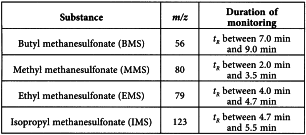Appendix VIII S. Methyl, Ethyl and Isopropyl Methanesulfonate in Methanesulfonic Acid
The following method has been validated for the methyl, ethyl and isopropyl esters of methanesulfonic acid at concentrations in the range of 0.5 ppm to 100 ppm.
If it is intended to be used to determine levels of methanesulfonic acid esters outside this validated range, for example in early steps of the synthesis prior to their removal, the concentration of the test solution has to be adjusted accordingly.
Gas chromatography (2.2.28) coupled with mass spectrometry (2.2.43).
Internal standard solution Dilute 7 µL of butyl methanesulfonate CRS (BMS) to 10.0 mL with methylene chloride R. Dilute 10 µL of the solution to 100.0 mL with methylene chloride R.
Test solution Add 0.74 g of the substance to be examined to 10.0 mL of water R and extract with 10.0 mL of the internal standard solution. Allow to separate and transfer the organic layer to a vial containing anhydrous sodium sulfate R. Shake and filter.
Reference solution (a) Dissolve 50 mg each of methyl methanesulfonate R (MMS), ethyl methanesulfonate R (EMS) and isopropyl methanesulfonate R (IMS) in the internal standard solution and dilute to 50.0 mL with the same solution. Dilute 74 µL of the solution to 10.0 mL with the internal standard solution. Dilute 100 µL of this solution to 10.0 mL with the internal standard solution.
Reference solution (b) Dilute 3.0 mL of reference solution (a) to 10.0 mL with the internal standard solution.
Carrier gas helium for chromatography R.
Flow rate 1 mL/min.
Pulsed splitless 250 kPa, 0.25 min.
Detection Mass spectrometer as described below; adjust the detector settings so as to comply with the system suitability criteria:
Injection 2 µL.
Relative retention With reference to the internal standard (BMS) (retention time = about 7.6 min): MMS = about 0.3; EMS = about 0.5; IMS = about 0.6.
Calculate the content of MMS, EMS or IMS in parts per million using the following expression:
| A1 | = | area of the peak due to MMS, EMS or IMS in the chromatogram obtained with reference solution (a); |
| A2 | = | area of the peak due to MMS, EMS or IMS in the chromatogram obtained with the test solution; |
| C | = | percentage content of MMS, EMS or IMS; |
| I1 | = | area of the peak due to the internal standard in the chromatogram obtained with reference solution (a); |
| I2 | = | area of the peak due to the internal standard in the chromatogram obtained with the test solution; |
| W1 | = | mass of MMS, EMS or IMS used to prepare reference solution (a), in milligrams; |
| W2 | = | mass of the substance to be examined in the test solution, in milligrams; |
| 0.148 | = | dilution factor. |


